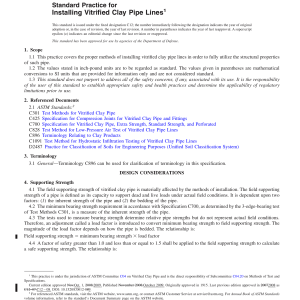ASTM-C12:2009 Edition(Redline)
$26.65
C12-09 Standard Practice for Installing Vitrified Clay Pipe Lines (Redline)
| Published By | Publication Date | Number of Pages |
| ASTM | 2009 | 8 |
This practice covers the proper methods of installing vitified clay pipe lines in order to fully utilize the structural properties of such pipe. The external loads on installed vitrified clay pipe are of two general types: (I) dead loads and (2) live loads. For pipes installed in trenches at a given depth, the dead load increases as the trench width, measured at the top of the pipe, increases. Live loads that act at the ground surface are partially transmitted to the pipe. Live loads may be produced by wheel loading, construction equipment or by compactive effort. Classes of bedding and encasements for pipe in trenches are defined as Class D wherein the pipe shall be placed on a firm and unyielding trench bottom with bell holes provided, Class C wherein the pipe shall be bedded in clean coarse-grained gravels and sands, Class B wherein the pipe shall be bedded in suitable material and Class A. Trenches shall be excavated to a width that will provide adequate working space, but not more than the maximum design width. Trench walls shall not be undercut. Bell holes shall be excavated to prevent point loading of the bells or couplings of laid pipe, and to establish full-length support of the pipe barrel. Final backfill need not be compacted to develop field supporting strength of the pipe. Final backfill may require compaction to prevent settlement of the ground surface.
This abstract is a brief summary of the referenced standard. It is informational only and not an official part of the standard; the full text of the standard itself must be referred to for its use and application. ASTM does not give any warranty express or implied or make any representation that the contents of this abstract are accurate, complete or up to date.
1. Scope
1.1 This practice covers the proper methods of installing vitrified clay pipe lines in order to fully utilize the structural properties of such pipe.
1.2 The values stated in inch-pound units are to be regarded as standard. The values given in parentheses are mathematical conversions to SI units that are provided for information only and are not considered standard.
1.3 This standard does not purport to address all of the safety concerns, if any, associated with its use. It is the responsibility of the user of this standard to establish appropriate safety and health practices and determine the applicability of regulatory limitations prior to use.
2. Referenced Documents (purchase separately) The documents listed below are referenced within the subject standard but are not provided as part of the standard.
ASTM Standards
C301 Test Methods for Vitrified Clay Pipe C425 Specification for Compression Joints for Vitrified Clay Pipe and Fittings C700 Specification for Vitrified Clay Pipe, Extra Strength, Standard Strength, and Perforated C828 Test Method for Low-Pressure Air Test of Vitrified Clay Pipe Lines C896 Terminology Relating to Clay Products C1091 Test Method for Hydrostatic Infiltration Testing of Vitrified Clay Pipe Lines D2487 Practice for Classification of Soils for Engineering Purposes (Unified Soil Classification System)
Keywords
backfilling; bedding; clay pipe; compaction; construction; design; excavation; installation; load factors; perforated pipe; pipe; sewers; trench foundation; trenching; vitrified; Vitrified clay pipe/fittings; Backfill; Bedding; Clay pipe/piping systems; Compaction control; Construction; Design–piping systems; Excavation site; Leachate drainage; Trenches; Underground installation;
ICS Code
ICS Number Code 23.040.01 (Pipeline components in general. Pipelines)
DOI: 10.1520/C0012-09 ASTM International is a member of CrossRef.
Citing ASTM Standards
[Back to Top]











































